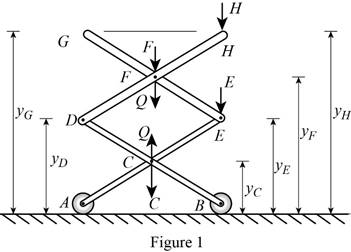
(a)
Find the force in the spring and the vertical motion of point G when a vertical load of
(a)
Answer to Problem 10.5P
The force in the spring is
The vertical motion of point G is
Explanation of Solution
Given information:
The spring constant is
Calculation:
Show the free-body diagram of the spring assembly as in Figure 1.

Write the relation of the deflections at point G, H, F, E, D with C as follows;
The deflection
Assume the spring force Q is in tension.
Find the force in the spring Q using the relation.
Here, the spring constant is k.
Substitute
Use the virtual work principle:
Here,
Substitute 120 N for C,
The spring force Q is in compression. The assumption is incorrect.
Therefore, the force in the spring is
Substitute –60 N for Q in Equation (1).
Find the vertical motion
Substitute –2 mm for
Therefore, the vertical motion of point G is
(b)
Find the force in the spring and the vertical motion of point G when a vertical load of
(b)
Answer to Problem 10.5P
The force in the spring is
The vertical motion of point G is
Explanation of Solution
Given information:
The spring constant is
Calculation:
Use the virtual work principle:
Here,
Substitute 120 N for C,
The spring force Q is in compression. The assumption is incorrect.
Therefore, the force in the spring is
Substitute –300 N for Q in Equation (1).
Find the vertical motion
Substitute –10 mm for
Therefore, the vertical motion of point G is
Want to see more full solutions like this?
Chapter 10 Solutions
VECTOR MECHANIC
- 4. Now consider the figure below showing a wooden block subjected to biaxial loading, and its stress state in the laboratory coordinate system. The grain in the wood is aligned at an angle of 15° to the vertical direction as shown. Determine the stress state in the orientation of the grain. Y σy = 1.8 MPa 15° σx = 3 MPa ох ==arrow_forwardplease hand-written solution only!arrow_forwardhand-written solution only please!arrow_forward
- handwritten solutions only, please!arrow_forwardOn from the equation: 2 u = C₁ + C₂ Y + Czy + Cu y³ Find C₁, C₂, C3 and Cy Using these following Cases : (a) 4=0 at y=0 (b) U = U∞ at y = 8 du (c) at Y = S ду --y. ди = 0 at y = 0 бугarrow_forwardI need help with a MATLAB code. I am trying to solve this question. Based on the Mars powered landing scenariosolve Eq. (14) via convex programming. Report the consumed fuel, and discuss the results with relevant plots. I am using the following MATLAB code and getting an error. I tried to fix the error and I get another one saying something about log and exp not being convex. Can you help fix my code and make sure it works. The error is CVX Warning: Models involving "log" or other functions in the log, exp, and entropy family are solved using an experimental successive approximation method. This method is slower and less reliable than the method CVX employs for other models. Please see the section of the user's guide entitled The successive approximation method for more details about the approach, and for instructions on how to suppress this warning message in the future.Error using .* (line 173)Disciplined convex programming error: Cannot perform the operation:…arrow_forward
- Note: please use integration for parabolic volume (Vp) of the fluid displaced due to rotation. (Make it simpe as possible to follow in the working out). Provide a clear, step-by-step simplified handwritten solution (with no extra explanations) that is entirely produced by hand without any AI help. I require an expert-level answer, and I will assess it based on the quality and accuracy of the work, referring to the attached image for additional guidance. Make sure every detail is carefully verified for correctness before you submit. Thanks!.arrow_forwardNote: use centroid method please Provide a clear, step-by-step simplified handwritten solution (with no extra explanations) that is entirely produced by hand without any AI help. I require an expert-level answer, and I will assess it based on the quality and accuracy of the work, referring to the attached image for additional guidance. Make sure every detail is carefully verified for correctness before you submit. Thanks!.arrow_forwardCalculate the cutting time for a 4 in length of cut, given that the feed rate is 0.030 ipr at a speed of 90 fpm.arrow_forward
- for the values: M1=0.41m, M2=1.8m, M3=0.56m, please account for these in the equations. also please ensure that the final answer is the flow rate in litres per second for each part. please use bernoullis equation where needed if an empirical solutions i srequired. also The solutions should include, but not be limited to, the equations used tosolve the problems, the charts used to solve the problems, detailed working,choice of variables, the control volume considered, justification anddiscussion of results etc.If determining the friction factor, the use of both Moody chart and empiricalequations should be used to verify the validity of the valuearrow_forwardSolve this problem and show all of the workarrow_forwardSolve this problem and show all of the workarrow_forward
 Elements Of ElectromagneticsMechanical EngineeringISBN:9780190698614Author:Sadiku, Matthew N. O.Publisher:Oxford University Press
Elements Of ElectromagneticsMechanical EngineeringISBN:9780190698614Author:Sadiku, Matthew N. O.Publisher:Oxford University Press Mechanics of Materials (10th Edition)Mechanical EngineeringISBN:9780134319650Author:Russell C. HibbelerPublisher:PEARSON
Mechanics of Materials (10th Edition)Mechanical EngineeringISBN:9780134319650Author:Russell C. HibbelerPublisher:PEARSON Thermodynamics: An Engineering ApproachMechanical EngineeringISBN:9781259822674Author:Yunus A. Cengel Dr., Michael A. BolesPublisher:McGraw-Hill Education
Thermodynamics: An Engineering ApproachMechanical EngineeringISBN:9781259822674Author:Yunus A. Cengel Dr., Michael A. BolesPublisher:McGraw-Hill Education Control Systems EngineeringMechanical EngineeringISBN:9781118170519Author:Norman S. NisePublisher:WILEY
Control Systems EngineeringMechanical EngineeringISBN:9781118170519Author:Norman S. NisePublisher:WILEY Mechanics of Materials (MindTap Course List)Mechanical EngineeringISBN:9781337093347Author:Barry J. Goodno, James M. GerePublisher:Cengage Learning
Mechanics of Materials (MindTap Course List)Mechanical EngineeringISBN:9781337093347Author:Barry J. Goodno, James M. GerePublisher:Cengage Learning Engineering Mechanics: StaticsMechanical EngineeringISBN:9781118807330Author:James L. Meriam, L. G. Kraige, J. N. BoltonPublisher:WILEY
Engineering Mechanics: StaticsMechanical EngineeringISBN:9781118807330Author:James L. Meriam, L. G. Kraige, J. N. BoltonPublisher:WILEY





